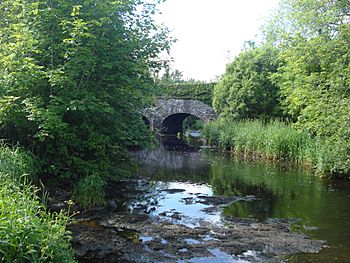Inagh River facts for kids
Quick facts for kids Inagh River |
|
|---|---|

R460 crossing the Inagh River
|
|
| Native name | An Eidhneach |
| Other name(s) | Cullenagh River |
| Country | Ireland |
| Settlements | Inagh, Ennistymon, Lahinch |
| Physical characteristics | |
| Main source | Knockadangan, County Clare |
| River mouth | Atlantic Ocean at Lahinch |
| Length | 36.61 kilometres (22.75 mi) |
| Basin features | |
| Basin size | 168 km2 (65 sq mi) |
| Tributaries |
|
The Inagh River is a beautiful river located in County Clare, in the western part of Ireland. It's an important natural feature of the area. The river gets its name from the Irish word eidhneach, which means "abounding in ivy". This suggests that ivy plants might have grown a lot along its banks in the past.
The Inagh River is also sometimes called the Cullenagh River. It flows through several towns and villages, including Inagh, Ennistymon, and Lahinch.
Contents
Where Does the Inagh River Start and End?
The Inagh River begins its journey in a place called Knockadangan, which is in County Clare. From there, it flows for about 36.61 kilometers (or 22.75 miles).
As it travels, the river collects water from smaller streams and lakes. One important river that joins it is the Dealagh River. The Inagh River also connects with Dumcullaun Lough and Lough Aconnaun.
The River's Journey to the Sea
The Inagh River eventually reaches the Atlantic Ocean. It flows into Liscannor Bay at a popular coastal town called Lahinch. Before reaching the ocean, the river even flows through the famous Lahinch Golf Course.
What Historical Sites Are Along the River?
The Inagh River has been an important part of the landscape for a very long time. Along its banks, you can find the ruins of old castles.
Discovering Dough Castle
One of the most famous historical sites is Dough Castle. Its ruins are located right on the banks of the Inagh River, within the Lahinch Golf Course. This castle has a long history and tells stories of the past.
O'Brien's Castle: A Lost Landmark
Another castle, known as O'Brien's Castle, also once stood along the Inagh River. However, its ruins are no longer visible today. The river is also crossed by a bridge that shares the same name as the river itself.


